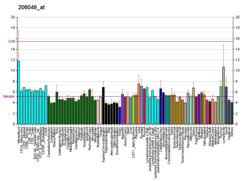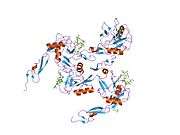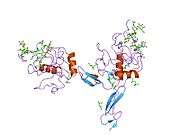P-selectin
P-selectin is a protein that in humans is encoded by the SELP gene.[5]
P-selectin functions as a cell adhesion molecule (CAM) on the surfaces of activated endothelial cells, which line the inner surface of blood vessels, and activated platelets. In unactivated endothelial cells, it is stored in granules called Weibel-Palade bodies. In unactivated platelets P-selectin is stored in α-granules.
Other names for P-selectin include CD62P, Granule Membrane Protein 140 (GMP-140), and Platelet Activation-Dependent Granule to External Membrane Protein (PADGEM). It was first identified in endothelial cells in 1989.[6]
Gene and regulation
P-selectin is located on chromosome 1q21-q24, spans > 50 kb and contains 17 exons in humans.[7] P-selectin is constitutively expressed in megakaryocytes (the precursor of platelets) and endothelial cells.[8] P-selectin expression is induced by two distinct mechanisms. First, P-selectin is synthesized by megakaryocytes and endothelial cells, where it is sorted into the membranes of secretory granules.[9] When megakaryocytes and endothelial cells are activated by agonists such as thrombin, P-selectin is rapidly translocated to the plasma membrane from granules.[10] Secondly, increased levels of P-selectin mRNA and protein are induced by inflammatory mediators such as tumor necrosis factor-a (TNF-a), LPS, and interleukin-4 (IL-4). Although TNF-a and LPS increase levels of both mRNA and protein in murine models, they do not appear to affect mRNA in human endothelial cells, while IL-4 increases P-selectin transcription in both species.[11][12][13] The elevated synthesis of P-selectin may play an important role in the delivery of protein to the cell surface. In ischemic stroke patients, plasma P-selectin concentration was reported to be highly correlated to plasminogen activator inhibitor-1 activity and tissue plasminogen activator activity.[14]
Structure
P-selectin is found in endothelial cells and platelets where it is stored in Weibel-Palade bodies and α-granules, respectively. In response to inflammatory cytokines such as IL-4 and IL-13, P-selectin is translocated to the plasma membrane in endothelial cells.[15] The extracellular region of P-selectin is composed of three different domains like other selectin types; a C-type lectin-like domain in the N-terminus, an EGF-like domain and a complement-binding protein-like domains (same as complement regulatory proteins: CRP) having short consensus repeats (~60 amino acids). The number of CRP repeats is the major feature differentiating the type of selectin in extracellular region. In human, P-selectin has nine repeats while E-selectin contains six and L-selectin has only two. P-selectin is anchored in transmembrane region that is followed by a short cytoplasmic tail region.[16]
Ligand
The primary ligand for P-selectin is P-selectin glycoprotein ligand-1 (PSGL-1) which is expressed on almost all leukocytes, although P-selectin also binds to heparan sulfate and fucoidans. PSGL-1 is situated on various hematopoietic cells such as neutrophils, eosinophils, lymphocytes, and monocytes, in which it mediates tethering and adhesion of these cells. However, PSGL-1 is not specific for P-selectin, as it can also function as a ligand for both E- and L-selectin.[17]
Function
P-selectin plays an essential role in the initial recruitment of leukocytes (white blood cells) to the site of injury during inflammation. When endothelial cells are activated by molecules such as histamine or thrombin during inflammation, P-selectin moves from an internal cell location to the endothelial cell surface.
Thrombin is one trigger which can stimulate endothelial-cell release of P-selectin and recent studies suggest an additional Ca2+-independent pathway involved in the release of P-selectin.[18]
Ligands for P-selectin on eosinophils and neutrophils are similar sialylated, protease-sensitive, endo-beta-galactosidase-resistant structures, clearly different than those reported for E-selectin, and suggest disparate roles for P-selectin and E-selectin during recruitment during inflammatory responses.[19]
P-selectin is also very important in the recruitment and aggregation of platelets at areas of vascular injury. In a quiescent platelet, P-selectin is located on the inner wall of α-granules. Platelet activation (through agonists such as thrombin, Type II collagen and ADP) results in "membrane flipping" where the platelet releases α- and dense granules and the inner walls of the granules are exposed on the outside of the cell. The P-selectin then promotes platelet aggregation through platelet-fibrin and platelet-platelet binding.
P-selectin attaches to the actin cytoskeleton through anchor proteins that are still poorly characterized.
Role in cancer
P-selectin has a functional role in tumour metastasis similar to E-selectin.[20] P-selectin is expressed on the surface of both stimulated endothelial cells and activated platelets, and helps cancer cells invade into the bloodstream for metastasis and provides local multiple growth factors, respectively.[21] Moreover, platelets facilitate tumor metastasis by forming complexes with tumour cells and leukocytes in the vasculature, thus preventing recognition by macrophages. This is thought to contribute to the seeding of tumour microemboli in distant organs.[22] In vivo mice experiments have shown that a reduction in circulating platelets could reduce cancer metastasis.[23]
The oligosaccharide sialylated Lewis x (sLe(x)) is expressed on the surface of tumor cells and can be recognized by E-selectin and P-selectin, playing on a key role in metastasis of the tumor. However, in the 4T1 breast cancer cell line, E-selectin reactivity is sLe(x) dependent while P-selectin reactivity is sLe(x)-independent, suggesting P-selectin binding is Ca2+-independent and sulfation-dependent.[24] One of the sulfated ligands is chondroitin sulfate, a type of glycosaminoglycan (GAG). Its activity in tumor metastasis has been probed by the addition of heparin that functions to blocks tumor metastasis. In addition to GAGs, mucin is of interest in P-selectin mediated tumor metastasis.[25] Selective removal of mucin results in reduced interaction between P-selectin and platelets in vivo and in vitro.[22]
Heparin has long been known to represent antiheparanase activity that is to keep an endoglycosidase from degrading heparin sulfate, one of the glycosaminoglycans, and to effectively inhibit P-selectin.[26] Despite a striking effect of heparin on tumor progression shown in a number of clinical trials,[27] the use of heparin as anti-cancer agent is limited because of its risk, which might induce adverse bleeding complications. Given those reasons, development of new compounds that target P-selectin is now emerging for cancer therapy. Among them, the inhibitory activity of semisynthetic sulfated tri mannose C-C-linked dimers (STMCs) to P-selectin was shown by the attenuation of tumor metastasis in vivo animal model, indicating the inhibition of interaction between tumor cell and endothelial cell is significant for blocking tumor dissemination.[28]
As a drug target
Crizanlizumab is a monoclonal antibody against P-selectin.[29] which has now been approved by Novartis on November 15, 2019 for the indication of vaso-occlusive crisis in sickle cell patients.
See also
References
- GRCh38: Ensembl release 89: ENSG00000174175 - Ensembl, May 2017
- GRCm38: Ensembl release 89: ENSMUSG00000026580 - Ensembl, May 2017
- "Human PubMed Reference:". National Center for Biotechnology Information, U.S. National Library of Medicine.
- "Mouse PubMed Reference:". National Center for Biotechnology Information, U.S. National Library of Medicine.
- Ryan US, Worthington RE (February 1992). "Cell-cell contact mechanisms". Curr. Opin. Immunol. 4 (1): 33–7. doi:10.1016/0952-7915(92)90120-4. PMID 1375831.
- McEver RP, Beckstead JH, Moore KL, Marshall-Carlson L, Bainton DF (July 1989). "GMP-140, a platelet alpha-granule membrane protein, is also synthesized by vascular endothelial cells and is localized in Weibel-Palade bodies". J. Clin. Invest. 84 (1): 92–9. doi:10.1172/JCI114175. PMC 303957. PMID 2472431.
- Herrmann SM, Ricard S, Nicaud V, Mallet C, Evans A, Ruidavets JB, Arveiler D, Luc G, Cambien F (August 1998). "The P-selectin gene is highly polymorphic: reduced frequency of the Pro715 allele carriers in patients with myocardial infarction". Hum. Mol. Genet. 7 (8): 1277–84. doi:10.1093/hmg/7.8.1277. PMID 9668170.
- Pan J, Xia L, McEver RP (April 1998). "Comparison of promoters for the murine and human P-selectin genes suggests species-specific and conserved mechanisms for transcriptional regulation in endothelial cells". J. Biol. Chem. 273 (16): 10058–67. doi:10.1074/jbc.273.16.10058. PMID 9545353.
- Disdier M, Morrissey JH, Fugate RD, Bainton DF, McEver RP (March 1992). "Cytoplasmic domain of P-selectin (CD62) contains the signal for sorting into the regulated secretory pathway". Mol. Biol. Cell. 3 (3): 309–21. doi:10.1091/mbc.3.3.309. PMC 275532. PMID 1378326.
- Hattori R, Hamilton KK, Fugate RD, McEver RP, Sims PJ (May 1989). "Stimulated secretion of endothelial von Willebrand factor is accompanied by rapid redistribution to the cell surface of the intracellular granule membrane protein GMP-140". J. Biol. Chem. 264 (14): 7768–71. PMID 2470733.
- Hahne M, Jäger U, Isenmann S, Hallmann R, Vestweber D (May 1993). "Five tumor necrosis factor-inducible cell adhesion mechanisms on the surface of mouse endothelioma cells mediate the binding of leukocytes". J. Cell Biol. 121 (3): 655–64. doi:10.1083/jcb.121.3.655. PMC 2119562. PMID 7683689.
- Liu Z, Miner JJ, Yago T, Yao L, Lupu F, Xia L, McEver RP (2010). "Differential regulation of human and murine P-selectin expression and function in vivo". The Journal of Experimental Medicine. 207: 2975–2987. doi:10.1084/jem.20101545.
- Panes, et al. (February 1999). "Leukocyte-endothelial cell adhesion: avenues for therapeutic intervention". Br J Pharmacol. 126 (3): 537–550 [538]. doi:10.1038/sj.bjp.0702328. PMC 1565837.
- Wang J, Li J, Liu Q (August 2005). "Association between platelet activation and fibrinolysis in acute stroke patients". Neurosci. Lett. 384 (3): 305–9. doi:10.1016/j.neulet.2005.04.090. PMID 15916851.
- Woltmann G, McNulty CA, Dewson G, Symon FA, Wardlaw AJ (May 2000). "Interleukin-13 induces PSGL-1/P-selectin-dependent adhesion of eosinophils, but not neutrophils, to human umbilical vein endothelial cells under flow". Blood. 95 (10): 3146–52. doi:10.1182/blood.V95.10.3146. PMID 10807781.
- Vestweber D, Blanks JE (January 1999). "Mechanisms that regulate the function of the selectins and their ligands". Physiol. Rev. 79 (1): 181–213. doi:10.1152/physrev.1999.79.1.181. PMID 9922371.
- Lorenzon P, Vecile E, Nardon E, Ferrero E, Harlan JM, Tedesco F, Dobrina A (September 1998). "Endothelial cell E- and P-selectin and vascular cell adhesion molecule-1 function as signaling receptors". J. Cell Biol. 142 (5): 1381–91. doi:10.1083/jcb.142.5.1381. PMC 2149355. PMID 9732297.
- Cleator JH, Zhu WQ, Vaughan DE, Hamm HE (April 2006). "Differential regulation of endothelial exocytosis of P-selectin and von Willebrand factor by protease-activated receptors and cAMP". Blood. 107 (7): 2736–44. doi:10.1182/blood-2004-07-2698. PMC 1895372. PMID 16332977.
- Wein M, Sterbinsky SA, Bickel CA, Schleimer RP, Bochner BS (March 1995). "Comparison of human eosinophil and neutrophil ligands for P-selectin: ligands for P-selectin differ from those for E-selectin". Am. J. Respir. Cell Mol. Biol. 12 (3): 315–9. doi:10.1165/ajrcmb.12.3.7532979. PMID 7532979.
- Köhler S, Ullrich S, Richter U, Schumacher U (February 2010). "E-/P-selectins and colon carcinoma metastasis: first in vivo evidence for their crucial role in a clinically relevant model of spontaneous metastasis formation in the lung". Br. J. Cancer. 102 (3): 602–9. doi:10.1038/sj.bjc.6605492. PMC 2822933. PMID 20010946.
- Chen M, Geng JG (2006). "P-selectin mediates adhesion of leukocytes, platelets, and cancer cells in inflammation, thrombosis, and cancer growth and metastasis". Arch. Immunol. Ther. Exp. (Warsz.). 54 (2): 75–84. doi:10.1007/s00005-006-0010-6. PMID 16648968.
- Borsig L, Wong R, Feramisco J, Nadeau DR, Varki NM, Varki A (March 2001). "Heparin and cancer revisited: mechanistic connections involving platelets, P-selectin, carcinoma mucins, and tumor metastasis". Proc. Natl. Acad. Sci. U.S.A. 98 (6): 3352–7. doi:10.1073/pnas.061615598. PMC 30657. PMID 11248082.
- Gasic GJ (1984). "Role of plasma, platelets, and endothelial cells in tumor metastasis". Cancer Metastasis Rev. 3 (2): 99–114. doi:10.1007/BF00047657. PMID 6386144.
- Monzavi-Karbassi B, Stanley JS, Hennings L, Jousheghany F, Artaud C, Shaaf S, Kieber-Emmons T (March 2007). "Chondroitin sulfate glycosaminoglycans as major P-selectin ligands on metastatic breast cancer cell lines". Int. J. Cancer. 120 (6): 1179–91. doi:10.1002/ijc.22424. PMID 17154173.
- Garcia J, Callewaert N, Borsig L (February 2007). "P-selectin mediates metastatic progression through binding to sulfatides on tumor cells". Glycobiology. 17 (2): 185–96. doi:10.1093/glycob/cwl059. PMID 17043066.
- Bar-Ner M, Eldor A, Wasserman L, Matzner Y, Cohen IR, Fuks Z, Vlodavsky I (August 1987). "Inhibition of heparanase-mediated degradation of extracellular matrix heparan sulfate by non-anticoagulant heparin species". Blood. 70 (2): 551–7. doi:10.1182/blood.V70.2.551.551. PMID 2955820.
- Lazo-Langner A, Goss GD, Spaans JN, Rodger MA (April 2007). "The effect of low-molecular-weight heparin on cancer survival. A systematic review and meta-analysis of randomized trials". J. Thromb. Haemost. 5 (4): 729–37. doi:10.1111/j.1538-7836.2007.02427.x. PMID 17408406.
- Borsig L, Vlodavsky I, Ishai-Michaeli R, Torri G, Vismara E (May 2011). "Sulfated hexasaccharides attenuate metastasis by inhibition of P-selectin and heparanase". Neoplasia. 13 (5): 445–52. doi:10.1593/neo.101734. PMC 3084621. PMID 21532885.
- Ataga, Kenneth I.; Kutlar, Abdullah; Kanter, Julie; Liles, Darla; Cancado, Rodolfo; Friedrisch, João; Guthrie, Troy H.; Knight-Madden, Jennifer; Alvarez, Ofelia A.; Gordeuk, Victor R.; Gualandro, Sandra; Colella, Marina P.; Smith, Wally R.; Rollins, Scott A.; Stocker, Jonathan W.; Rother, Russell P. (2017). "Crizanlizumab for the Prevention of Pain Crises in Sickle Cell Disease". New England Journal of Medicine. 376 (5): 429–439. doi:10.1056/NEJMoa1611770. PMC 5481200. PMID 27959701.
Further reading
- Bajorath J, Stenkamp R, Aruffo A (1994). "Knowledge-based model building of proteins: concepts and examples". Protein Sci. 2 (11): 1798–810. doi:10.1002/pro.5560021103. PMC 2142283. PMID 7505680.
- Varki NM, Varki A (2002). "Heparin inhibition of selectin-mediated interactions during the hematogenous phase of carcinoma metastasis: rationale for clinical studies in humans". Semin. Thromb. Hemost. 28 (1): 53–66. doi:10.1055/s-2002-20564. PMID 11885026.
- Furie B, Furie BC (2004). "Role of platelet P-selectin and microparticle PSGL-1 in thrombus formation". Trends in Molecular Medicine. 10 (4): 171–8. doi:10.1016/j.molmed.2004.02.008. PMID 15059608.
- Cambien B, Wagner DD (2004). "A new role in hemostasis for the adhesion receptor P-selectin". Trends in Molecular Medicine. 10 (4): 179–86. doi:10.1016/j.molmed.2004.02.007. PMID 15059609.
- Chen M, Geng JG (2006). "P-selectin mediates adhesion of leukocytes, platelets, and cancer cells in inflammation, thrombosis, and cancer growth and metastasis". Arch. Immunol. Ther. Exp. (Warsz.). 54 (2): 75–84. doi:10.1007/s00005-006-0010-6. PMID 16648968.
External links
- P-Selectin at the US National Library of Medicine Medical Subject Headings (MeSH)
- Overview of all the structural information available in the PDB for UniProt: P16109 (Human P-selectin) at the PDBe-KB.
- Overview of all the structural information available in the PDB for UniProt: Q01102 (Mouse P-selectin) at the PDBe-KB.








